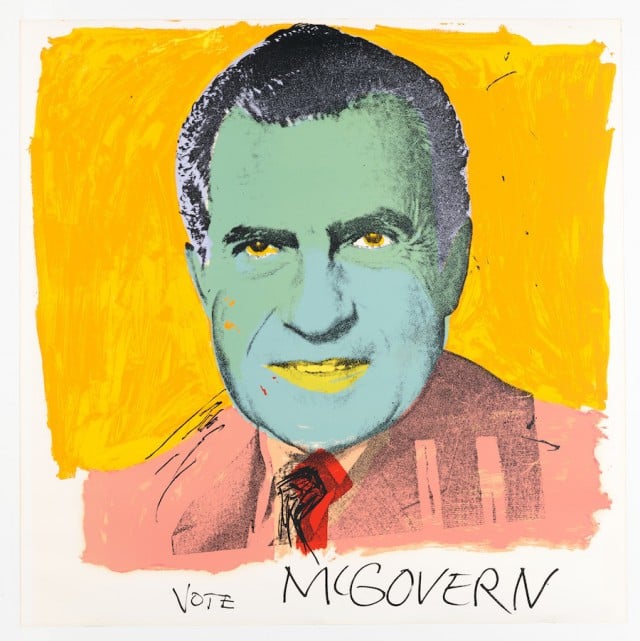Art & Exhibitions
At the Whitney, Warhol’s Brilliant Theft From Ben Shahn
THE DAILY PIC: To defeat Nixon, Warhol deployed his genius as a thief.

THE DAILY PIC: To defeat Nixon, Warhol deployed his genius as a thief.

Blake Gopnik


THE DAILY PIC (#1304, Whitney edition): This little-known print by Andy Warhol is now on view in the Whitney Museum’s giant re-do, at the foot of the High Line in Manhattan. Warhol made it in 1972, as a fundraising piece for Democratic presidential candidate George McGovern. He was capitalizing on the fact that many supporters would probably be pushing for the Democrat out of simple disgust with Nixon – Tricky Dick here presented more or less as the Wicked Witch of the West (who happens to have been a favorite of Andy’s).
But there’s one thing to note about Warhol’s strategy: He stole it, lock, stock and barrel, from a similar show-the-other-guy image done by Ben Shahn in 1964, supporting Lyndon Johnson against Barry Goldwater.
Now, in the context of Warhol, this doesn’t (quite) count as a shameful act: His entire career depended on his genius as a sponge, and people had known it for years – especially with regard to Shahn. The “blotted line” that defined Warhol’s commercial illustrations, in the 1950s, was built on an obvious imitation of the fractured mark-making that was already a trademark of Shahn, then one of America’s best-known artists. Warhol’s commercial clients have said that they thought of Andy as Shahn-on-the-cheap, and as Shahn without all the far-left baggage.
In the case of Warhol’s Nixon image, however, there’s more at stake. (There always is, with Warhol – that’s how he ended up being greater than Shahn.) For one thing, the theft must have been recognized as such by the kind of politically-informed artsies the print would have been targeted at. That means it wasn’t a theft, so much as a witty riff and homage – Shahn’s image, only eight years old, updated for a new age. The Warholian style of the 1972 image means that it acts as a youth-culture stamp of approval for McGovern.
Also, Warhol was so much more famous, by ‘72, than even Shahn had ever been that the piece comes to have three notable figures as its subject – McGovern, Nixon and Warhol – rather than simply the two in Shahn’s piece. One decade after the invention of Warhol’s silkscreen technique, every portrait that uses it is also, in some sense, a self-portrait of the artist. Not-Nixon is Warhol, as much as it’s McGovern.
Vote Democratic, and you’re voting Warholian. (No wonder Nixon won.) (© 2015 The Andy Warhol Foundation for Visual Arts/Artists Rights Society (ARS), N.Y.)
For a full survey of past Daily Pics visit blakegopnik.com/archive.